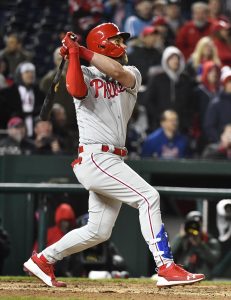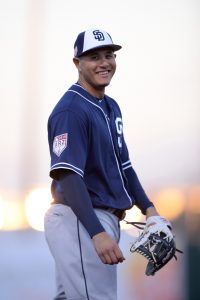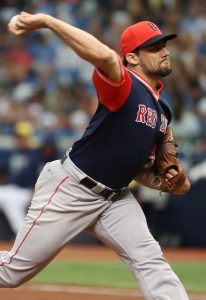This is the latest post of MLBTR’s annual Offseason in Review series, in which we take stock of every team’s winter dealings.
The Reds promised to grow their payroll and backed up their bawdy talk with three significant trades.
Major League Signings
- Zach Duke, LHP, one-year, $2MM
Trades and Claims
- Acquired RF Yasiel Puig, OF Matt Kemp, LHP Alex Wood, and C/INF Kyle Farmer from the Dodgers for RHP Homer Bailey, RHP Josiah Gray, and IF Jeter Downs
- Acquired RHP Tanner Roark from the Nationals for RHP Tanner Rainey
- Acquired RHP Sonny Gray and LHP Reiver Sanmartin from the Yankees for 2B Shed Long and a Competitive Balance Round A draft pick (Long was then traded to the Mariners for CF Josh Stowers)
- Claimed RHP Matt Bowman off waivers from Cardinals
- Claimed C Juan Graterol from Twins, then non-tendered him, then signed to minor-league deal
- Claimed 1B/OF Jordan Patterson from Mets, then non-tendered him, then signed to minor-league deal
- Selected 1B/OF Connor Joe with 7th overall pick in Rule 5 Draft
- Acquired RHP Jordan Johnson and cash from Giants for 1B/OF Connor Joe
Extensions
- Raisel Iglesias, RP: 3 years, $24.235MM
- Sonny Gray, SP: 3 years, $30.5MM
Notable Minor League Signings
- Jose Iglesias, Derek Dietrich, Anthony Bass, Ian Krol, Odrisamer Despaigne, Buddy Boshers, Felix Jorge, Tim Adleman, Christian Colon, Kyle Wren
Notable Losses
[Cincinnati Reds Depth Chart] [Cincinnati Reds Payroll Outlook]
Needs Addressed
After four straight last-place finishes and five consecutive years of declining attendance, the Reds entered the offseason with a deserved sense of urgency. At 20,116 fans per game in 2018, the Reds drew roughly 5,000 less fans than local United Soccer League team FC Cincinnati, who not only set USL attendance records for the third straight year, but also became the first Cincinnati franchise to win a playoff series since 1995. Cincinnati craves a winner, and the Reds promised to move in that direction by raising their payroll by upwards of $30MM this winter. President of baseball operations Dick Williams’ bolstered the claim with an aggressive offseason strategy of proactive player acquisition.
The Reds checked all their boxes and proved true to their word with perhaps the splashiest move of the offseason, acquiring Yasiel Puig, Alex Wood, Matt Kemp and Kyle Farmer from the Dodgers for Homer Bailey, Josiah Gray and Jeter Downs. For a team struggling to draw crowds, adding an entertainment machine like Puig was a pretty nifty way to squeeze an extra few drops of value from the final $28MM owed Bailey, and they did so without compromising future spending. With Wood, Puig, and Kemp all on expiring deals, the Reds only took on about $7MM in payroll while turning one -1.5 rWAR player into three more viable contributors. That counts as a win in most books, even if it did cost them two promising (though not upper echelon) prospects.
Wood slots right into the middle of their rotation (when healthy), becoming the second new addition to the rotation after having swapped Tanners with the Nats earlier in the winter (giving up Rainey for Washington’s Roark). Puig becomes the new starter in right, and though Kemp’s resurgence was short-lived, he still provides ample right-handed power off the bench. Not for nothing, but Farmer is a piece, too. Admittedly, he’s no spring chicken at age-28 with only 97 big league plate appearances to his name, but he’s brought his bat to every level of the minors, including last year when he slashed .288/.333/.451 in Triple-A. Maybe that doesn’t knock your socks off, but grade it on a curve for catchers and he’s a fine depth option to stash in Triple-A.
As for the rotation, neither Wood nor Roark are world-beaters, but they fortify the base of an annually rickety starting crew and take some pressure off Luis Castillo. Still, after reportedly hunting many big-names stars this winter — Corey Kluber, J.T. Realmuto, Noah Syndergaard, James Paxton and free agent Dallas Keuchel — snagging a crowd of useful non-stars probably doesn’t match the highs of fan expectation after such bawdy talk from ownership.
The acquisition of embattled Yankees starter Sonny Gray thusly became their most significant get, especially given the three-year, $30.5MM extension that keeps him in Cincinnati through 2022. Moving from the AL East to a more subdued environment in Ohio should help as the Reds try to work their Matt Harvey magic to rehab Gray in the wake of a difficult stint in New York. Granted, the back-to-back 200-inning, sub-3.10 ERA seasons he posted with Oakland were way back in 2014-15, and the bandbox that is Great American Ballpark does him no favors. Nonetheless, this is a former All-Star with a top-three Cy Young finish and a 3.74 career FIP across 900 2/3 big-league innings. Teaming Gray with Castillo, Wood, Roark and Anthony DeSclafani, the Reds finally have a rotation that doesn’t include picking a name out of a hat every fifth day.
Charged with leading this crew is first-year manager and third-generation Cincinnati Red David Bell. The Giants’ former VP of Player Development returns home after having managed in the Reds system from 2009 to 2012. Though he’s an old-school baseball lifer, he plans to engage analytics and contemporary tactics, at the very least regarding usage of the newly-extended Raisel Iglesias. While nominally the closer, Iglesias will be Bell’s fireman, deployed wherever and whenever he’s needed most. The bullpen also added affordable lefty Zach Duke to a sneaky good group that includes David Hernandez, Jared Hughes, Amir Garrett, and Michael Lorenzen on the second line behind Iglesias. Minor league signees Bass, Boshers, Krol and Despaigne are depth options who can each claim at least some degree of success at the big league level.
The offense, meanwhile, was mostly settled at the outset of winter. Joey Votto, Scooter Gennett, Jose Peraza and Eugenio Suarez were in line to get the majority of infield at-bats, though a late-spring injury to Gennett has altered those plans for the time being. Tucker Barnhart will take the bulk of time behind the plate. Curt Casali reprises his role as the backup after nailing the trial run with a .293/.355/.450 output in 156 plate appearances in 2018. Adding Puig and Kemp to Scott Schebler and Jesse Winker means there’s plenty of bodies in the outfield, and top prospect Nick Senzel should join that mix once his injured ankle mends (and, perhaps, once he gets some more minor league reps in center field under his belt).
Off the bench, the additions of Iglesias and Dietrich complement the starters nicely. Iglesias completes the skill sets of Peraza and Genett as a glove-first option at short, and his presence is all the more important with Gennett potentially out into the month of June. Iglesias will log significant time at shortstop for the foreseeable future as the versatile Peraza slides to the other side of the bag in place of Gennett. Dietrich, too, will see some time at second base, giving the Reds a bat-first option there; he was nine percent better than the league average with the bat last year (and for his career) by measure of wRC+. Cincinnati is already plenty deep in the outfield, but Dietrich has his share of experience there as well should the need arise.
Questions Remaining
Let’s put this bluntly: the Reds don’t have a center fielder. What they have is a crew of potential contenders vying for the honor to learn the position on the fly. The spot may be earmarked for Senzel, but he’s a converted infielder who is still new to the position. Schebler entered the season with 358 career innings in center. Kemp is no longer an option there, and Puig has been primarily a right fielder. On Fangraphs’ Effectively Wild seasons preview, C. Trent Rosencrans of the Athletic called reliever and two-way hopeful Michael Lorenzen the best defensive center fielder currently on the Reds’ roster. The Reds will use him out there occasionally after seeing him hit .290/.333/.710 with four home runs in 34 plate appearances last season, but he won’t be a regular.
Senzel, currently Baseball America’s 10th ranked prospect overall, already transitioned from third base to second base in Triple-A, and there’s no shortage of examples of players who have made the jump from infield to outfield. Trea Turner learned center field on the fly for the Nationals after only a six-game tryout in Triple-A. Ketel Marte is making the transition for the Diamondbacks this season. There was hope the Reds fervor for contention would push them to buck current trends and start Senzel in center from the jump, but alas, Senzel was set to begin the year in Triple-A even before incurring the aforementioned ankle injury.
Without a true center fielder on the roster, the Reds turned to Schebler to begin the season there. If his .255/.337/.439 line across 107 games last year doesn’t inspire you, neither will his defense. He does have familiarity with the position having started and even earned passable defensive marks with -1 DRS, -0.9 UZR over what is, admittedly, a small sample size over the past three years. What’s disconcerting is he has not graded well defensively in right field in his career (0 DRS, -4.8 UZR), and that’s over more than 2000 frames compared to the sum total of 358 1/3 innings in center.
The most intriguing part about this race is there is no safety net. The Reds are all-in on this current arrangement, however it shakes out. Phil Ervin has some experience in center but has spent more time in the corners over the past few seasons in Triple-A. (He also hasn’t hit much in Triple-A or the minors.) Jose Siri, Stuart Fairchild, and TJ Friedl may be the next in line, but none had even played a game in Double-A prior to Opening Day. Taylor Trammell is among the game’s most highly regarded minor leaguers, but he’s at least a year and maybe two away. Schebler is the safe option, but Senzel figures to take over at some point. An eventual timeshare seems most judicious, but you’d like to see a high-end defensive options in the mix as well.
Aside from center, the biggest questions remain, remarkably, in the rotation. Absent from the rotation conversation above is the fact that Wood opened the season on the injured list. Tyler Mahle is a fine short-term replacement, and Wood shouldn’t be out long. Regardless, one of Bell’s first tests as a manager will be managing the workload of his new staff and keeping this crew healthy. Roark has been a workhorse, but the others haven’t surpassed 170 innings in a season since 2015 (if ever). Both Gray and Roark are also in need of a rebound season, and if that doesn’t pan out, the Reds’ alternatives lie in the same slate of internal options that prompted them to acquire three starting pitchers this offseason.
2019 Season Outlook
It’s been a miserable start to the season, although if there’s consolation for the 1-8 Reds, it’s that the Cubs (2-7) and Cardinals (4-5) haven’t exactly stormed out of the gates either. The Reds should be competitive enough for the rest of the year to lure more traffic through the turnstiles, but to outlast a deep field in the National League, they’ll need the starting staff to fire on all cylinders. That means Gray has to get right, Wood has to get healthy and, in a perfect world, Castillo would take a step towards acedom.
Although they increased payroll, the Reds’ offseason additions weren’t reckless. The numerous expiring contracts double as a kind of ejector seat for this early attempt at contention should the slow start turn into a true tailspin. Moving Puig, Wood, and/or Roark (among others) at the deadline could recoup some of the prospect capital it cost to acquire them. That’s a worst case scenario, really, and given their recent history, consider it a step in the right direction.
How would you grade their offseason? (Link for app users.)





